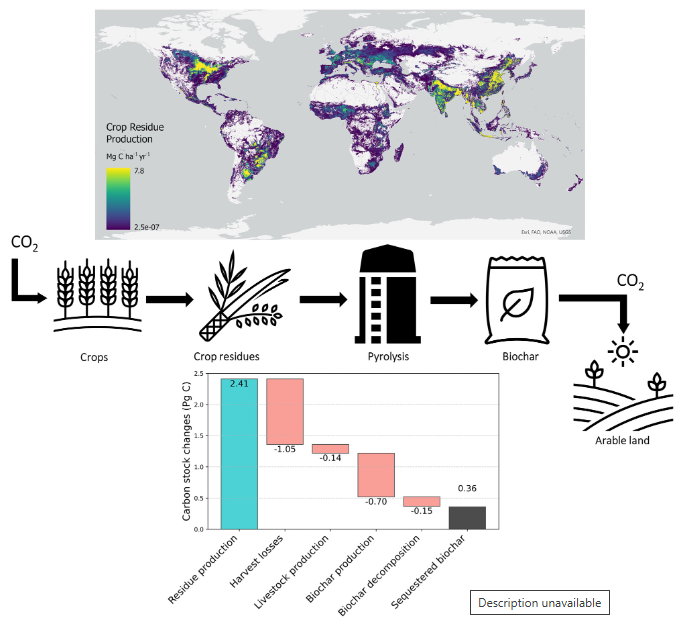
Research highlights
- First global mapping of sustainable biochar carbon sequestration potential from crop residues.
- High-resolution spatial analysis identifies regional hotspots for maximum climate impact.
- Sustainable technical potential estimated at 0.62–1.03 Gt C yr⁻¹ (2.28–3.78 Gt CO₂ yr⁻¹).
- Co-benefits include improved soil health, nutrient retention, and reduced residue burning.
Resources
Reference
Karan, S., Woolf, D., Azzi, E., Sundberg, C., & Wood, S. A. (2023). Potential for biochar carbon sequestration from crop residues: A global spatially explicit assessment. Global Change Biology. Bioenergy/GCB Bioenergy, 15(12), 1424–1436. https://doi.org/10.1111/gcbb.13102
Data Sources
Global crop production and residue datasets (FAOSTAT, SPAM), biochar yield factors from published pyrolysis studies, and carbon stability coefficients from peer-reviewed literature.
Model
Global geospatial model that links crop residue production to biochar output and its long-term carbon storage in soils. It combines crop data, sustainable residue removal rates, pyrolysis yields, and biochar stability factors to estimate technical sequestration potential and map regional hotspots.
Want to read more?
Abstract
This study provides the first global, spatially explicit assessment of the technical potential for biochar carbon sequestration from crop residues, identifying where and how much carbon could be stored annually. Using high-resolution spatial data on crop residue availability, biochar yield, and stability, the research estimates a maximum sustainable sequestration potential of 0.62–1.03 Gt C yr⁻¹, equivalent to 2.28–3.78 Gt CO₂ yr⁻¹, if all available residues were used without compromising soil health. The work also maps regional patterns, highlights co-benefits such as soil fertility improvement and waste reduction, and examines the implications for carbon dioxide removal (CDR) strategies and climate policy.
Methodology
Data integration: Combined global datasets on crop production, residue-to-crop ratios, and sustainable removal rates to calculate available residue biomass at a 0.5° × 0.5° spatial resolution.
Biochar yield estimation: Applied established pyrolysis conversion factors to estimate biochar mass from available residues.
Carbon stability modelling: Used mean residence time and stability fraction values to estimate the long-term carbon storage potential of biochar in soils.
Scenario analysis: Developed lower- and upper-bound sequestration estimates based on conservative and optimistic stability and yield assumptions.
Geospatial mapping: Mapped technical potential across major crop-producing regions to identify global hotspots for biochar deployment.
Key Findings
Global potential: Sustainable technical potential ranges from 0.62 to 1.03 Gt C yr⁻¹ (2.28–3.78 Gt CO₂ yr⁻¹).
Regional hotspots: Highest potentials found in East Asia, South Asia, and parts of Sub-Saharan Africa, reflecting both high residue production and favourable conditions for biochar stability.
Feedstock diversity: Major contributions from cereals (rice, wheat, maize) with regional variation in dominant residue types.
Co-benefits: Biochar application can improve soil health, enhance nutrient retention, and reduce open burning of residues.
Limitations: Estimates do not account for economic, logistic, or policy barriers; actual deployable potential may be lower.
Impact and Next Steps
Climate relevance: Biochar from crop residues could contribute substantially to global CDR portfolios, helping close the gap to net-zero targets.
Policy implications: Identified hotspots can guide targeted incentives, infrastructure investment, and MRV frameworks for biochar deployment.
Next steps: Incorporate economic feasibility, supply chain constraints, and competing residue uses into refined potential estimates; develop region-specific deployment strategies; and assess integration with other agricultural and waste management systems.